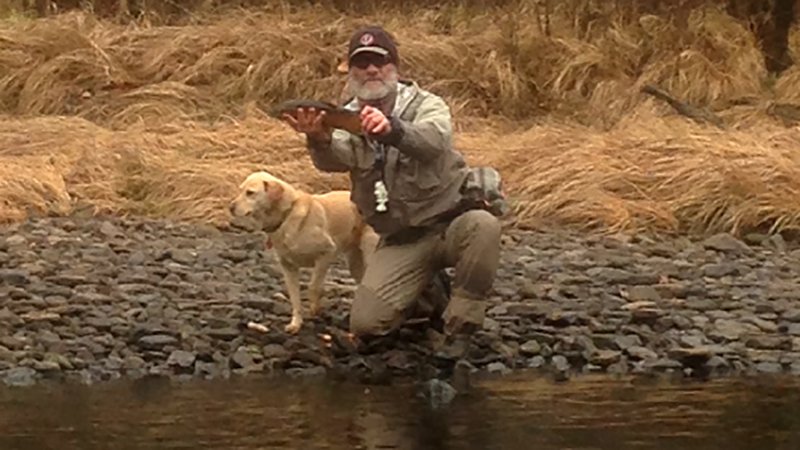Cool weather equals hot fishing on Arkansas’s famous trout tailwaters
ON 10-24-2018

Oct. 24, 2018
Randy Zellers
Assistant Chief of Communications
HEBER SPRINGS – As the need for air-conditioning and sandals gives way to the need for a Thermos of coffee and layered clothes, many anglers abandon the water and place their tackle in hibernation mode. But for some die-hard anglers, the best time of year to chase trout is just getting started.
Tom Bly, district fisheries supervisor in the Arkansas Game and Fish Commission’s Mayflower Office, works closely with the AGFC trout biologists to manage the fishery on the Little Red River below Greers Ferry Dam. He, like many AGFC biologists, also enjoys his fair share of angling when the work day is done.
“I think I might even enjoy a little more than my fair share when it comes to trout,” Bly said. “And fall is a great time to get out and truly enjoy the aesthetics of angling many died-in-the-wool trout anglers enjoy.”
Bly says once hunting seasons begin to open and the warm days of summer begin to wane, most of the crowds vacate the tailwaters. Not only does it allow anglers to visit more areas without any competition and use boat ramps without lines or parking issues, it also relieves some fishing pressure, which can mean a little more cooperation from the fish.
Some pretty major changes are happening under the water to make for uncrowded conditions as well.
“Ambient temperatures are dropping, so the water downstream will be cooler,” Bly said. “Trout that are there won’t be as stressed from the high temperatures of summer. You have a little more area to cover, but that means more area to spread out and fish.”
And unlike Arkansas’s warm-water species that spawn in spring, the prime time to find a spawning fish is just beginning.
“Trout are fall and winter spawners,” Bly said. “So our wild brown trout will begin staging and spawning. The rainbows in the system will follow them to feed on eggs, so you have aggressive rainbows and aggressive browns, many of which are heavier than they will be all year.”
Bly says the brown trout will spawn from late October all the way through the middle of January. Because the water is coming from the bottom of Greers Ferry, water temperatures in the tailwater remain fairly constant, even during short periods of extremely cold or warm weather, especially near the dam. This means a reliable progression of trout throughout each spawning season for anglers to target.
“Anglers looking for trout during the fall should look for the same sorts of cover and structure as normal,” Bly said. “Living in a stream means finding areas that are sheltered from the current while being close enough to let that same current bring food to you. There they can save the energy of fighting the constant flow and still eat well.”
Bly’s favorite areas to target are bottom structure like holes, drop offs and humps. Any places where deep water comes up into a shoal-like area creates an unseen eddie fitting Bly’s definition of a prime trout lie.
Pockets and seams in aquatic vegetation create another type of current break favored by trout. In addition to the slower water, vegetation and the substrate where it grows offers many aquatic insects and crustaceans for fish to eat.
“If you’re looking for brown trout, really target seams in vegetation,” Bly said. “Browns tend to hold tighter to cover than rainbows, which is part of the reason I think they tend to be caught less frequently than the stocked rainbows. They’re the dominant predator in the river, so they’ll push other fish out of the prime lies where fishing for them is more difficult. Rainbows tend to pod up more in groups where they’re easier to catch by anglers who can drift and not hang up.”
Bly says brown trout in the Little Red River also tend to be more picky about their food because they are wild. Rainbows raised in hatcheries are less critical of the food they eat, but mimicking natural forage is a key to chasing the larger browns.
“The sowbug is probably the number one forage and the number one and two fly pattern anglers should focus on,” Bly said. “It is by far the most prevalent aquatic crustacean in the river. There are a lot of them in the substrate and tons of the little guys clinging to aquatic vegetation.
Sowbugs usually are only ¼- to ½-inch long, and are similar in appearance to the roly polys many of us played with as children. Aside from being a top food source for trout, they are an extremely easy fly to make, which makes them even more popular with fly anglers on the Little Red.
“We also have some sculpin in the river and aquatic worms, but sowbugs really are the one food source trout take the most advantage of here,” Bly said. “Sowbugs, San Juan worms and egg patterns are must haves for a fly angler on this body of water.
Bly favors these patterns, but he’s also a firm believer in using whatever lure gives the angler the most confidence.
“You can just about catch a trout using an armadillo on a stick if you’re confident enough in it to stick with it,” Bly said. “I prefer to fly fish, but I’ll use spinning gear with jigs and have no problem with an angler using bait where it’s legal. Go with whatever method and gear to get out here.”
Bly encourages anyone who visits the river to take a few precautions to help maintain this incredible fishery during their trip. Foremost among them are to keep a keen eye out while wading during the fall for the brown trout’s spawning beds, called redds.
Redds will appear as slight oval-shaped depressions in gravel that will have a slightly lighter color from having the silt whisked off as the trout fanned the area with its tail. The trout will lay eggs in these depressions, then guard them from predators.
“It takes a little work to find your first few, but once you know what you’re looking for and where they typically occur in the section of stream you’re fishing, they stand out pretty well,” Bly said. “Wading near or through these areas or trying to fish right on top of the redds can destroy the eggs or leave them vulnerable to predation. It’s best to search for trout that are actively feeding instead of those guarding young.”
When anglers do hook into a trout they intend to release, Bly suggests they enjoy the fight, but not play the fish to exhaustion.
“And I always take the time to hold the fish upright in the stream pointed upriver so that water can flow over its gills to help it recover,” Bly said. “Released trout have a much greater chance of survival when you minimize the amount of time you’re handling them for photos and celebration and focus on keeping them healthy.”
Visit www.agfc.com/en/fishing/sportfish/trout/ for more information on trout fishing in Arkansas.
Recent News

Arkansas Wildlife Weekly Fishing Report
Jul. 10, 2025

Lonoke aquaculturist named to AGFC
Jul. 10, 2025
Subscribe to Our Weekly Newsletter E-mails
Don’t miss another issue. Sign up now to receive the AGFC Wildlife Weekly Newsletter in your mailbox every Wednesday afternoon (Waterfowl Reports are published weekly during waterfowl season and periodically outside the season). Fishing Reports arrive on Thursdays. Fill in the following fields and hit submit. Thanks, and welcome!
